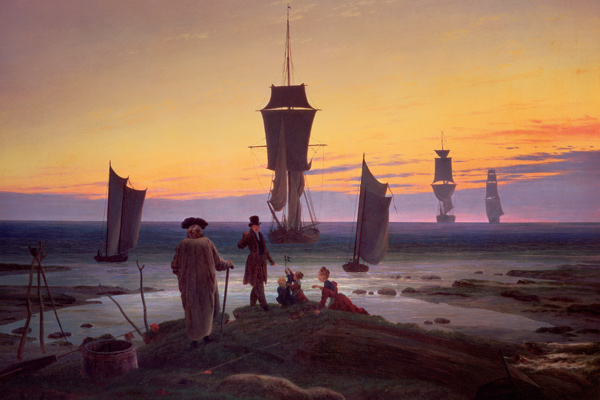In October 1810, the poet and dramatist Heinrich von Kleist substantially rewrote a review submitted to a publication he edited, the Berliner Abendblätter. Indeed, as few editors would dare — even in those days — he transformed its tone from critical to positive. The subject was a landscape by Caspar David Friedrich, ‘The Monk by the Sea’ painted c. 1808-10, which was exhibited in Berlin.
In the course of his remarks Kleist came up with a startling metaphor:
This painting, with its two or three mysterious elements, lies there like the apocalypse … and since, in its monotony and boundlessness, it has nothing, other than the frame, that might serve as a foreground, the feeling one has gazing at it is as though one’s eyelids had been cut away.
The subject of Friedrich’s landscape — which consists essentially of just the dark sea and sky, with a solitary figure looking out from the shore — may have struck a personal chord. A year later, in a suicide pact, Kleist shot himself and his lover Henriette Vogel beside a lake near Potsdam, the Kleiner Wannsee. But he was by no means the only observer on whom Friedrich’s art, and this image in particular, made a powerful impression.
In conversation, contemporary artists as diverse and prominent as Anish Kapoor, Anselm Kiefer and James Turrell have all singled Friedrich out as an important predecessor and inspiration. The American art historian and critic Robert Rosenblum entitled a celebrated book, Modern Painting and the Northern Romantic Tradition: Friedrich to Rothko.
It’s true that on looking at ‘The Monk by the Sea’ you get the impression of confronting the void, mysterious infinity — much in fact as you might feel when looking at an abstract painting of a century and a half later by Mark Rothko. There are several great artists in the period around 1800 — Goya, Turner, Constable, Ingres — of whom you might say modern art starts with them.
Friedrich is certainly one of these. The reason, Johannes Grave argues in this handsome new book, is that Friedrich’s paintings set up a visual conundrum: a sense that there is more to the scene you are looking at than you can quite grasp. That — the uncertainty principle you could call it, to borrow a phrase — is quintessentially modern.
Friedrich (1774-1840) was born in Greifswald, a town on the Baltic coast, and at that time part of the kingdom of Sweden. An early patron referred to him, quaintly, as a ‘Norseman’. Thus he grew up in a northern Baltic world of long, long summer nights and dark winters (just like Rothko, as it happens, who spent his early life in what is now Latvia, but was then part of Russia).
Friedrich studied art in Copenhagen and spent most of his working life in Dresden. Although he painted the Alps, he never saw them; he belonged to a culture quite distinct from that of the Catholic areas of southern Germany. Crucially, he was a devout Protestant, which meant that he had an ingrained distrust of the power of images to depict religious and spiritual truths. So, put simply, the problem he set out to solve was how to paint a picture that suggested there were deep, perhaps unknowable, mysteries, without actually depicting anything except the natural world.
Sometimes in Friedrich’s paintings there are spectators, gazing — like the monk on the shore — at a prospect that is at once vast and enigmatic: the mountains swathed in mist, the night sea, the river Elbe, glimpsed through a window. In other pictures, such as his haunting late work ‘The Large Enclosure’ (1835) the viewer simply confronts huge expanse of flat land and darkening sky.
The melancholy that many find in Friedrich’s art may be the effect of that clear Baltic light, northern mists and gloom. A biographical explanation, however, might lie in an accident that happened on 8 December 1787. The teenage Friedrich and his brother Christoffer were skating on a frozen river when the future painter fell through the ice and Christoffer died saving him. In later life, a friend described Friedrich as having ‘a thick dark cloud of unclear circumstances in his mind’, but that probably applies to quite a few of us, artists included.
At times Grave’s text is rather densely philosophical. But after all, German romantic culture was densely philosophical. ‘Even to me’, Friedrich once wrote, ‘what I want to portray and how I want to portray it is, in a way, a puzzle.’ Although he is inclined to take complicated issue with previous Friedrich scholars, on the whole Grave provides a thoughtful introduction to the intellectual and visual complexities of this marvellous artist’s work.
The reproductions are lavish and splendid — which is just as well for the British reader, because almost all the originals are in the museums of Friedrich’s native lands, particularly in Berlin, Dresden and Hamburg. To see them you have to visit the north.






Comments